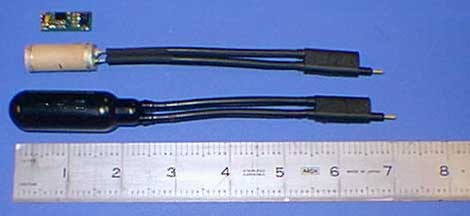Hydrophone/Receiver
A hydrophone is an underwater listening device. Just as a microphone is used to detect sound in the air, a hydrophone detects sounds in the water and converts the acoustic energy into electrical energy. Hydrophones listen to sounds in the sea, but do not transmit any sound, making them passive listening devices.
People were listening to underwater sounds with air tubes as early as 1490, when Leonardo da Vinci wrote about it. It was not until the mid to late 1800’s that the science developed to convert acoustic energy into electrical energy. This technology advanced enough that by World War II, British, French, and American scientists were using echo-ranging to locate icebergs and submarines. The ability to locate submarines was invaluable against the German U-Boats.
Most hydrophones are made from a piezoelectric material. This material produces small electrical charges when exposed to pressure changes. The pressure changes associated with a sound wave can be detected by a piezoelectric element. Under the pressure of a sound wave, the piezoelectric element flexes and in return gives off electrical signals. These electrical signals can be recorded and later analyzed with computer programs.

Photograph of a standard hydrophone. The upper picture is the preamplifier. The center picture is the ceramic element/preamplifier assembly (the preamplifier is housed inside the ceramic element). The lower picture is the final product that is encapsulated in urethane. Photo courtesy of Adrienne Spychalski, High Tech, Inc. (http://hightechincusa.com/)
Some hydrophones, called omnidirectional hydrophones, record sounds from all directions with equal sensitivity. Other hydrophones, called directional hydrophones, have a higher sensitivity to signals from a particular direction. Directional hydrophones are typically used in systems for locating and tracking objects.
Hydrophones are specially designed for underwater use. They are normally encased in a rubber boot to provide protection from seawater. Hydrophones can be mounted in several different ways. They can be attached to a boat, towed, or placed in a fixed position underwater
Additional Links on DOSITS
- How is sound measured?
- How is sound used to measure temperature in the ocean?
- How is sound used to navigate underwater?
- How is sound used to study marine mammal distribution?
Additional Resources
- Bifano, T. G., Cleveland, R. O., Compton, D. A., & Pierce, A. D. (1999). A novel microelectromechanical system (MEMS) design for an underwater acoustic field sensor. The Journal of the Acoustical Society of America, 105(2), 998–998. https://doi.org/10.1121/1.424817
- Able Sea Chicks Blog
- NOAA National Ocean Service – What is a Hydrophone?
- NOAA OER – Hydrophone in the Challeneger Deep
- NOAA Ocean Explorer, Technologies for Ocean Acoustic Monitoring.